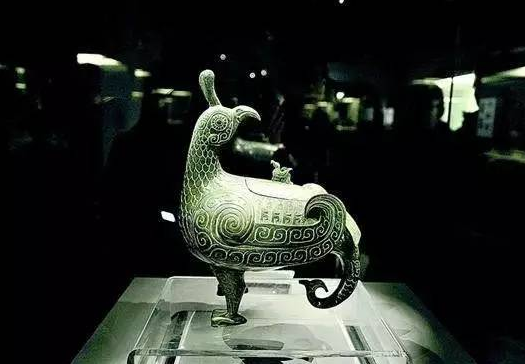Bronze Bird Zun of the Western Zhou Dynasty: Telling the ancients
The bird statue in the Shanxi Museum is a wine vessel, 39 cm high, 30.5 cm long and 17.5 cm wide. "Zhou Li" once recorded that there are "six statues and six Yi" ritual vessels in the ancestral temple of the Zhou Dynasty, and "bird statue" is one of them.
In the early years of the Western Zhou Dynasty, Zhou Chengwang "Tong Ye Fengdi", his compatriot brother Shu Yu was sealed to the ancient Tang Dynasty. After Shuyu's death, his son Xiefu inherited the fief. Because there was a Jinshui in the Tang land, Xiefu began to call him "Marquis of Jin", and eventually changed the name of Tang to "Jin", and Xiefu became the first Marquis of Jin. The owner of Bird Zun is Xiefu.
The bird statue was unearthed in 2000 at Tomb No. 114 of the Jinhou Cemetery in Beizhao Village, Quwo County, Linfen City, Shanxi Province. The archaeologists finally confirmed that this is the tomb of Xiefu, thus arranging a clear chronology of nine generations of Jinhou from Xiefu to the Jin Wenhou who escorted King Zhou Ping eastward to Luoyi. one of the major discoveries.
The whole utensil is mainly shaped by an upright big bird looking back. The big bird has a slightly raised head, round eyes, a high crown and a plump body. The tail of the big bird is bent down, gradually forming an elephant trunk, an elephant shape with both eyes and mouth, which is vivid and forms the third point of support for the utensils.
On the back of the bird statue, a small bird quietly depends on each other and becomes the catch on the cover of the bird statue. There are inscriptions "Jin Hou Zuoxiang Taishi Baozun Yi" in the belly and the cover, indicating that this is the ancestral temple of the Jin Kingdom. Important ritual utensils used in worship. The upper beak of the bird's beak can be opened and closed freely. It automatically opens when the wine is poured, and automatically closes when it is reset. The design is very ingenious.

Among the bronze wares in ancient my country, although there are not many bronze wares in the shape of animals as a whole, they are excellent products one after another, especially the bird-shaped wares, which can be called the artistic wonders of bronze culture.
The image of owl is the most common in the Yin and Shang dynasties. After two weeks, the image of cranes can be seen everywhere in the Central Plains, Qin and Chu. The image of geese is common in Qin and Han cultures, while the Jin culture clearly prefers beautiful phoenix birds and fierce birds of prey. Birds have pushed the bronze art of bird statues to the extreme with their superb design standards and beautiful decorative patterns.
Why did the Jin royal family prefer the image of the phoenix bird? As we all know, Tang Shuyu was a child of the Zhou family, and the Zhou people's phoenix-bird complex has long been known to every household because of the allusions of "Fengming Qishan". Zhouzu Houji's name was abandoned, and his mother's name was Jiang Yuan. Jiang Yuan stepped on the footsteps of a giant and gave birth to a boy. The clan thought it was a bad omen and abandoned the child. Just when the boy was shivering from the cold in the wild, a flock of phoenix birds flew in the air, using their wings to warm the child. Jiang Yuan thought that this son had divine help and decided to raise him as an adult. Because he was an outcast, he named him Abandoned. Although it is a legend, the ancients believed that without phoenix birds, there would be no Zhou people.
If you want to buy Chinese traditional bronze art, you can choose it at sculpmart.com.









